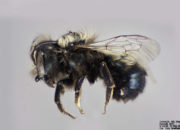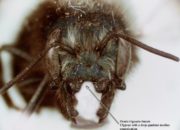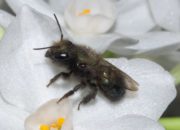This relatively large, blue bee is one of the first to emerge in the spring. Historical records exist for many Vermont counties, though records in the last decade are sparse and localized. Both males and females can be identified from decent photographs.
As a frequent inhabitant of “bee hotels“, this species is occasionally used commercially for pollination of apples and other spring blooming fruit crops.
There is some evidence that it is being replaced by two non-native Osmia in the same subgenus – Hornfaced Mason Bee (Osmia cornifrons) and Taurus Mason Bee (Osmia taurus), though it co-occurs with Hornfaced Bees at several semi-urban sites. Few, if any, records from the lower Champlain Valley.
Identification: The largest of the regularly occurring bright blue Osmia, similar in size to a honey bee. Females have dark scopal hairs and a distinct notch in the margin of the clypeus. Males are have very long antenna and abundant white hairs.
Similar Species
Bufflehead Mason Bee (O. bucephala) – Slightly later flight period. Bufflehead Mason Bees are less brilliant blue with more abundant pale hair on the body. Females have an oversized head, while males have a distinctly long spur on the hind tibia.
Other Osmia – Several other spring Osmia are similar, but most are either smaller or lack the brilliant blue shine.
To see the global distribution, check out the iNaturalist account, and toggle the GBIF layer on the map.
Unless otherwise specified, specimen photos in the grid are courtesy of Margarita Miklasevskaja at PCYU with funding from NSERC-CANPOLIN.









